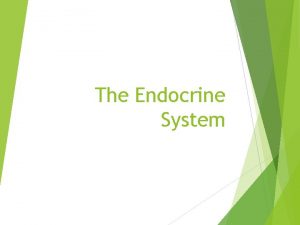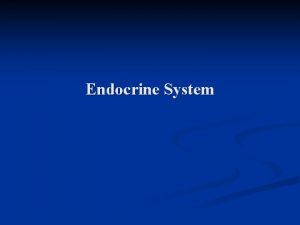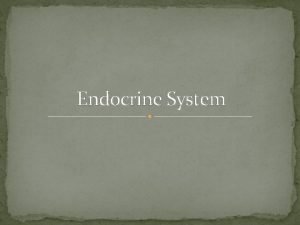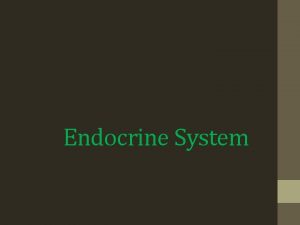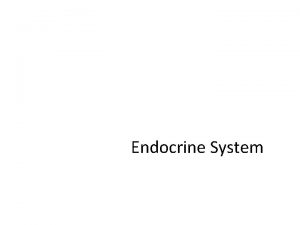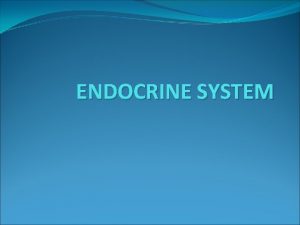ENDOCRINE SYSTEM Chapter 39 Sections 12 HORMONES Hormones









- Slides: 9

ENDOCRINE SYSTEM Chapter 39, Sections 1&2

HORMONES Hormones= Chemicals secreted by glands Exocrine Glands – Secrete hormones into organs directly or out of the body Endocrine Glands – Secrete hormones into blood Steroid Hormones – Lipid based and can pass in and out of cell membranes easily Nonsteroid Hormones – Cannot pass into cells easily.

GLAND LOCATIONS Glands are located throughout the body Hormones are “messages” used to regulate body activity through feedback inhibition Most hormones are secreted into the blood and trigger other glands to produce specific hormones

PITUITARY GLAND Located inside the brain “Master Gland” because it controls many other glands Hypothalamus causes the Pituitary to secrete specific hormones Growth Hormone Antidiuretic Hormone Reproductive Hormones Other Hormone

THYROID Plays major role in regulating body’s metabolism Hormone (Thyroxin) maintains homeostasis Overactive thyroid causes very fast metabolism Underactive thyroid causes slow metabolism (may lead to obeisity) Enlarged Thyroid is called Goiter

ADRENAL GLANDS Pyramid shaped gland that sits on top of kidney 2 structural parts Cortex: Produces the hormone, cortisol (control metabolism of food) Medulla: Produces the hormones Epinephrine and Norepinephrine (increases overall body activity in stress)

PANCREAS Important for maintaining blood sugar levels Produces hormones: Insulin: Allows sugar in blood to enter cells Glucogon: Increases amount of sugar in blood by breaking down complex carbs from liver and muscle. Both hormones are produced in the Islets of Langerhaans

PANCREAS DISORDER: DIABETES MELLITUS Type I Diabetes: Autoimmune disorder where Pancreas does not produce enough insulin Often diagnosed before age 15 Patients are normally dependent on insulin injections to allow sugar into cells Type II Diabetes: Pancreas slows down insulin production or cells cannot take in sugar Often diagnosed in 40’s or later Often managed by strict diet and exercise, insulin not normally needed

REPRODUCTIVE GLANDS: GONADS Females: Ovaries (Produce eggs) Hormones: Estrogen: female physical characteristics and egg formation Progesterone: prepares uterus for arrival of developing embryo Males: Testes (Produce Sperm) Hormone: Testosterone: Needed for normal sperm production and male physical characteristics










